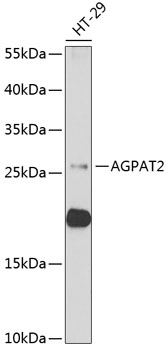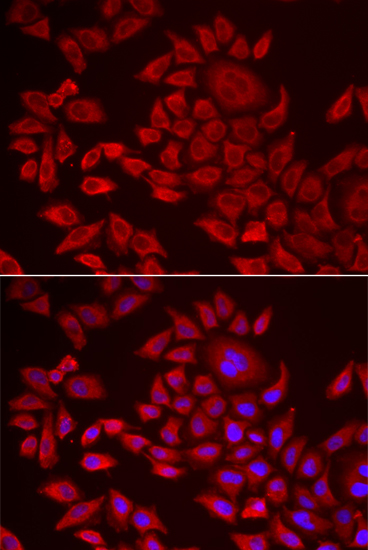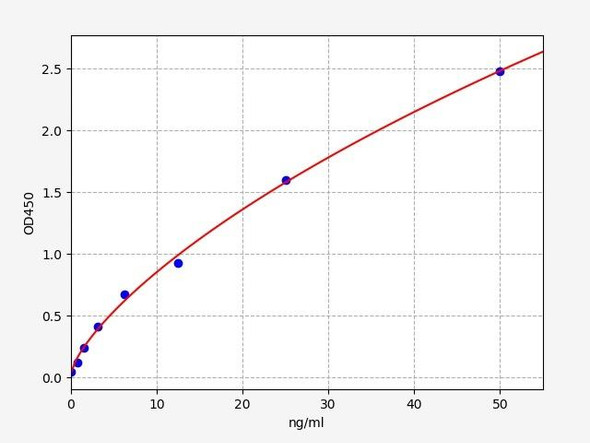Metabolism Antibodies 2
Anti-AGPAT2 Antibody (CAB6518)
- SKU:
- CAB6518
- Product Type:
- Antibody
- Reactivity:
- Human
- Reactivity:
- Mouse
- Host Species:
- Rabbit
- Isotype:
- IgG
- Antibody Type:
- Polyclonal Antibody
- Research Area:
- Metabolism
Description
| Antibody Name: | Anti-AGPAT2 Antibody |
| Antibody SKU: | CAB6518 |
| Antibody Size: | 20uL, 50uL, 100uL |
| Application: | WB IF |
| Reactivity: | Human, Mouse |
| Host Species: | Rabbit |
| Immunogen: | Recombinant fusion protein containing a sequence corresponding to amino acids 199-278 of human AGPAT2 (NP_006403.2). |
| Application: | WB IF |
| Recommended Dilution: | WB 1:500 - 1:2000 IF 1:50 - 1:100 |
| Reactivity: | Human, Mouse |
| Positive Samples: | HT-29 |
| Immunogen: | Recombinant fusion protein containing a sequence corresponding to amino acids 199-278 of human AGPAT2 (NP_006403.2). |
| Purification Method: | Affinity purification |
| Storage Buffer: | Store at -20'C. Avoid freeze / thaw cycles. Buffer: PBS with 0.02% sodium azide, 50% glycerol, pH7.3. |
| Isotype: | IgG |
| Sequence: | IVPV VYSS FSSF YNTK KKFF TSGT VTVQ VLEA IPTS GLTA ADVP ALVD TCHR AMRT TFLH ISKT PQEN GATA GSGV QPAQ |
| Gene ID: | 10555 |
| Uniprot: | O15120 |
| Cellular Location: | Endoplasmic reticulum membrane, Multi-pass membrane protein |
| Calculated MW: | 27kDa/30kDa |
| Observed MW: | 31kDa |
| Synonyms: | AGPAT2, 1-AGPAT2, BSCL, BSCL1, LPAAB, LPAAT-beta |
| Background: | This gene encodes a member of the 1-acylglycerol-3-phosphate O-acyltransferase family. The protein is located within the endoplasmic reticulum membrane and converts lysophosphatidic acid to phosphatidic acid, the second step in de novo phospholipid biosynthesis. Mutations in this gene have been associated with congenital generalized lipodystrophy (CGL), or Berardinelli-Seip syndrome, a disease characterized by a near absence of adipose tissue and severe insulin resistance. Alternate transcriptional splice variants, encoding different isoforms, have been characterized. |
| UniProt Protein Function: | AGPAT2: Converts lysophosphatidic acid (LPA) into phosphatidic acid by incorporating an acyl moiety at the sn-2 position of the glycerol backbone. Defects in AGPAT2 are the cause of congenital generalized lipodystrophy type 1 (CGL1); also known as Berardinelli-Seip congenital lipodystrophy type 1 (BSCL1) or Berardinelli-Seip syndrome. CGL1 is an autosomal recessive disorder characterized by marked paucity of adipose tissue, extreme insulin resistance, hypertriglyceridemia, hepatic steatosis and early onset of diabetes. Belongs to the 1-acyl-sn-glycerol-3-phosphate acyltransferase family. 2 isoforms of the human protein are produced by alternative splicing. |
| UniProt Protein Details: | Protein type:Transferase; Membrane protein, multi-pass; EC 2.3.1.51; Lipid Metabolism - glycerolipid; Membrane protein, integral; Lipid Metabolism - ether lipid; Lipid Metabolism - glycerophospholipid Chromosomal Location of Human Ortholog: 9q34.3 Cellular Component: endoplasmic reticulum membrane; endoplasmic reticulum; integral to membrane Molecular Function:1-acylglycerol-3-phosphate O-acyltransferase activity Biological Process: positive regulation of cytokine production; epidermis development; phospholipid metabolic process; glycerophospholipid biosynthetic process; phosphatidic acid biosynthetic process; triacylglycerol biosynthetic process; cellular lipid metabolic process; CDP-diacylglycerol biosynthetic process; positive regulation of cytokine and chemokine mediated signaling pathway Disease: Lipodystrophy, Congenital Generalized, Type 1 |
| NCBI Summary: | This gene encodes a member of the 1-acylglycerol-3-phosphate O-acyltransferase family. The protein is located within the endoplasmic reticulum membrane and converts lysophosphatidic acid to phosphatidic acid, the second step in de novo phospholipid biosynthesis. Mutations in this gene have been associated with congenital generalized lipodystrophy (CGL), or Berardinelli-Seip syndrome, a disease characterized by a near absence of adipose tissue and severe insulin resistance. Alternate transcriptional splice variants, encoding different isoforms, have been characterized. [provided by RefSeq, Jul 2008] |
| UniProt Code: | O15120 |
| NCBI GenInfo Identifier: | 3914362 |
| NCBI Gene ID: | 10555 |
| NCBI Accession: | O15120.1 |
| UniProt Secondary Accession: | O15120,O00516, O15106, Q5VUD3, Q5VUD4, Q9BSV7, Q9BWR7 |
| UniProt Related Accession: | O15120 |
| Molecular Weight: | 27,279 Da |
| NCBI Full Name: | 1-acyl-sn-glycerol-3-phosphate acyltransferase beta |
| NCBI Synonym Full Names: | 1-acylglycerol-3-phosphate O-acyltransferase 2 |
| NCBI Official Symbol: | AGPAT2 |
| NCBI Official Synonym Symbols: | BSCL; BSCL1; LPAAB; 1-AGPAT2; LPAAT-beta |
| NCBI Protein Information: | 1-acyl-sn-glycerol-3-phosphate acyltransferase beta; 1-AGPAT 2; 1-AGP acyltransferase 2; lysophosphatidic acid acyltransferase beta; lysophosphatidic acid acyltransferase-beta; 1-acylglycerol-3-phosphate O-acyltransferase 2 (lysophosphatidic acid acyltransferase, beta) |
| UniProt Protein Name: | 1-acyl-sn-glycerol-3-phosphate acyltransferase beta |
| UniProt Synonym Protein Names: | 1-acylglycerol-3-phosphate O-acyltransferase 2; 1-AGP acyltransferase 2; 1-AGPAT 2; Lysophosphatidic acid acyltransferase beta; LPAAT-beta |
| Protein Family: | 1-acyl-sn-glycerol-3-phosphate acyltransferase |
| UniProt Gene Name: | AGPAT2 |
| UniProt Entry Name: | PLCB_HUMAN |








